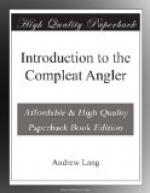This is the very ‘sprite’ of Walton; this has that vernal and matutinal air of opening European literature, full of birds’ music, and redolent of dawn. This is the note to which the age following Walton would not listen.
In matter of fact, again, Izaak follows the ancient Treatise. We know his jury of twelve flies: the Treatise says:—
’These ben the xij flyes wyth
whyche ye shall angle to the trought and
graylling, and dubbe like as ye
shall now here me tell.
’Marche. The donne fly, the body of the donne woll, and the wyngis of the pertryche. Another donne flye, the body of blacke woll, the wyngis of the blackyst drake; and the lay under the wynge and under the tayle.’
Walton has:—
’The first is the dun fly in March: the body is made of dun wool, the wings of the partridge’s feathers. The second is another dun fly: the body of black wool; and the wings made of the black drake’s feathers, and of the feathers under his tail.’
Again, the Treatise has:—
Auguste. The drake
fly. The body of black wull and lappyd abowte
wyth blacke sylke: winges of
the mayle of the blacke drake wyth a
blacke heed.’
Walton has:—
’The twelfth is the dark drake-fly,
good in August: the body made with
black wool, lapt about with black
silk, his wings are made with the
mail of the black drake, with a
black head.’
This is word for word a transcript of the fifteenth century Treatise. But Izaak cites, not the ancient Treatise, but Mr. Thomas Barker. {6} Barker, in fact, gives many more, and more variegated flies than Izaak offers in the jury of twelve which he rendered, from the old Treatise, into modern English. Sir Harris Nicolas says that the jury is from Leonard Mascall’s Booke of Fishing with Hooke and Line (London, 1609), but Mascall merely stole from the fifteenth-century book. In Cotton’s practice, and that of The Angler’s Vade Mecum (1681), flies were as numerous as among ourselves, and had, in many cases, the same names. Walton absurdly bids us ’let no part of the line touch the water, but the fly only.’ Barker says, ‘Let the fly light first into the water.’ Both men insist on fishing down stream, which is, of course, the opposite of the true art, for fish lie with their heads up stream, and trout are best approached from behind. Cotton admits of fishing both up and down, as the wind and stream may serve:




